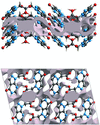issue contents
September 2022 issue

Cover illustration: The second-generation antihistamine ebastine is prescribed for treatment of allergic disorders. This report describes the use of fumarate as counter-ion resulting in the 1:1 salt ebastinium hydrogen fumarate. The structure is heavily disordered and the plate-shaped crystals obtained from different solvents all show pseudo-merohedral twinning. See: Priyanka, Jayanna, Kiran Kumar, Vinaya, Divakara, Yathirajan & Parkin [Acta Cryst. (2022). E78, 916–921].
modern approaches and tools for teaching crystallography
An easily accessible experimental set-up to grow large single crystals of two sweeteners readily available in supermarkets, erythritol and xylitol, is described. The crystallization of these compounds illustrates the principles of crystallization by evaporation·The crystal-growing experiment is complemented with a simple calorimetric set-up to demonstrate the endothermic nature of the dissolution of the selected sweeteners in a more quantitative approach by measuring the heat of dissolution.
research communications
Download citation


Download citation


The dihydropyrimidine ring in the title molecule is distinctly non-planar. In the crystal, zigzag chains parallel to [010] are formed by N—H⋯N hydrogen bonds and are connected into layers parallel to (100) by O—H⋯O, O—H⋯F, C—H⋯O, C—H⋯F and C—H⋯N hydrogen bonds. Further C—H⋯O hydrogen bonds connect the layers.
CCDC reference: 2177565
Download citation


Download citation


The crystal structure of the title compound has been characterized by single-crystal X-ray diffraction and Hirshfeld surface analyses. The molecular structure and frontier orbitals were also investigated using DFT.
CCDC reference: 2194365
Download citation


Download citation


An easy synthetic route towards ethyl 1-(3-tosylquinolin-4-yl)piperidine-4-carboxylate was found. Its molecular and crystal structures are described as well and the biological activity is also predicted using molecular docking studies.
CCDC reference: 2193735
Download citation


Download citation


The title compound was obtained unexpectedly by the reaction of Co(ClO4)2·6H2O and cytidine-5′-monophosphate with 4,4′-azopyridine in an aqueous solution of nitric acid. In the crystal, N—H⋯O hydrogen bonds between dications and anions lead to the formation of chains.
CCDC reference: 2163316
Download citation


Download citation


The title compound, 2-hydroxyimino-N-[1-(2-pyrazinyl)ethylidene]propanehydrazide, is a ligand able to form polynuclear metal complexes. The molecule is not planar due to a twist between the oxime and amide groups. In the crystal, molecules are linked by O—H⋯O hydrogen bonds into supramolecular chains.
CCDC reference: 2195126
Download citation


Download citation


The crystal structures of ligand precursor bis(imidaozolium) salts 1,1′-methylenebis(3-tert-butylimidazolium) dibromide monohydrate, C15H26N4+·2Br−·H2O or [tBuNHC2Me][Br]2·H2O, 1,1′-(ethane-1,2-diyl)bis(3-tert-butylimidazolium) dibromide dihydrate, C16H28N4+·2Br−·2H2O or [tBuNHC2Et][Br]2·2H2O, 1,1′-methylenebis[3-(2,4,6-trimethylphenyl)imidazolium] dibromide dihydrate, C25H30N42+·2Br−·2H2O or [MesNHC2Me][Br]2·2H2O, and 1,1′-1,1′-(ethane-1,2-diyl)bis[3-(2,4,6-trimethylphenyl)imidazolium] dibromide tetrahydrate, C26H32N42+·2Br−·4H2O or [MesNHC2Et][Br]2·4H2O, are reported. At 293 K, [tBuNHC2Me][Br]2·H2O crystallizes in the P21/c space group, while [tBuNHC2Et][Br]2·2H2O crystallizes in the P21/n space group at 100 K. At 112 K, [MesNHC2Me][Br]2·2H2O crystallizes in the orthorhombic space group Pccn while [MesNHC2Et][Br]2·4H2O crystallizes in the P21/c space group at 100 K.
Download citation


Download citation


In the molecular structures of the two title compounds, the central titanium(IV) atoms are coordinated in a distorted tetrahedral fashion. Thereby, the titanium atom is stabilized by the Lewis bases triphenylphosphine oxide (1) and p-fluorobenzonitrile (pFBN) (2) with dative O—Ti and N—Ti bonds, respectively.
Download citation


Download citation


Crystals of the title salt are twinned by pseudo-merohedry and the structure shows extensive disorder. A strong N—H⋯O hydrogen bond links the cation and the anion and the anions are linked into [010] chains by O—H⋯O hydrogen bonds.
CCDC reference: 2201292
Download citation


Download citation


The cup-shaped conformation of the title molecule is largely determined by an intramolecular N—H⋯O hydrogen bond. In the crystal, double layers of molecules are formed by O—H⋯O and C—H⋯O hydrogen bonds.
CCDC reference: 2194736
Download citation


Download citation


Crystal structure of an indium–salicylhydroximate complex cation: [In4(H2shi)8(H2O)6](NO3)4·8.57H2O
The title compound [In4(H2shi)8(H2O)6](NO3)4·8.57H2O·solvent, where H2shi− is salicylhydroximate, is a dimer of two [In2(H2shi)4(H2O)3]2+ units that are related by an inversion center. The overall configuration of the dimer has a step-like topology, and each InIII ion is seven coordinate with a pentagonal–bipyramidal geometry.
CCDC reference: 2195615
Download citation


Download citation


The title compound was obtained via the reaction of (1E,2E)-3-(3-methoxyphenyl)-1-phenylprop-2-en-1-one with ethyl 2-oxopropanoate, using NH4I as a catalyst. In the molecule, the four rings are not in the same plane, the pyridine ring being inclined to the benzene rings by 17.26 (6), 56.16 (3) and 24.50 (6)°. In the crystal, molecules are linked by C—H⋯π interactions into a three-dimensional network.
CCDC reference: 2194417
Download citation


Download citation


The structure of the acid chloride salt of the superbase N-butyl-2,3-bis(dicyclohexylamino)cyclopropenimine is reported.
CCDC reference: 2200141
Download citation


Download citation


In the title structure, the 2,3-dihydro-1H-indole ring system is nearly planar, while the conformation of the 4H-pyran ring is close to a flattened boat. The mean planes of these fragments are approximately perpendicular to each other. In the crystal, the molecules are connected into layers by N—H⋯N and N—H⋯O hydrogen bonds.
CCDC reference: 2202347
Download citation


Download citation


Two salts derived from N-(4-methoxyphenyl)piperazine crystallize with six independent molecular species in the asymmetric unit. In each compound, multiple hydrogen bonds link these components into complex sheets.
Download citation


Download citation


The bicyclic ring system is planar with the carboxymethyl group rotated out of this plane by 81.05 (5)°. In the crystal, corrugated layers are generated by N—H⋯O, O—H⋯N and C—H⋯O hydrogen-bonding interactions. The layers are associated through additional C—H⋯π(ring) interactions.
CCDC reference: 2203303
Download citation


Download citation


The structure of hexaaquanickel(II) bis(3-carboxy-4-hydroxybenzenesulfonate) dihydrate consists of alternating layers of inorganic cations and organic anions linked by O—H⋯O hydrogen bonds that also include non-coordinated water molecules of crystallization. The structure of hexaaquacobalt(II) bis(3-carboxybenzenesulfonate) dihydrate is also built of alternating layers of complex cations and organic anions without direct coordination to the metal by the protonated carboxylate or unprotonated sulfonate groups. A robust O—H⋯O hydrogen-bonding network involving primarily the coordinated and non-coordinated water molecules and sulfonate groups directs the packing.


 journal menu
journal menu



































